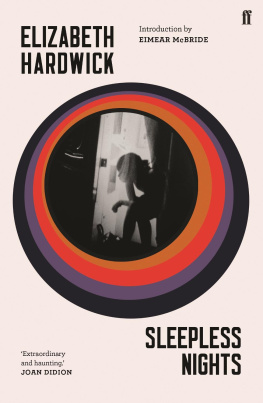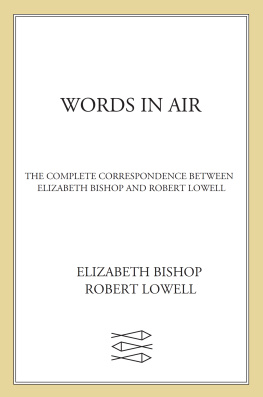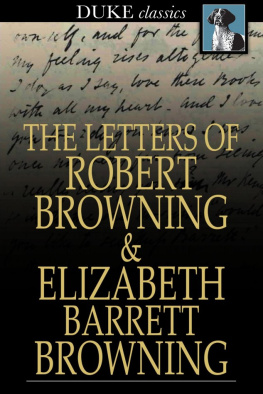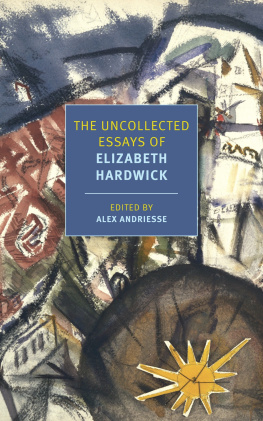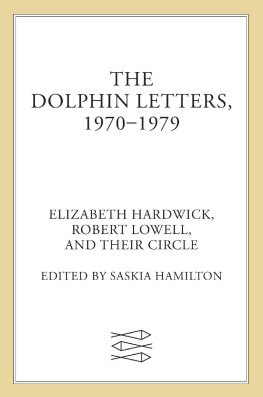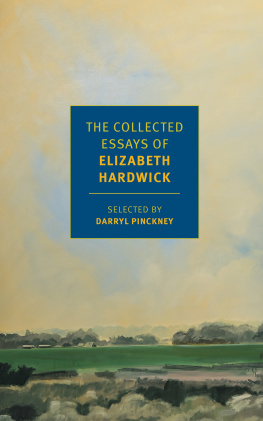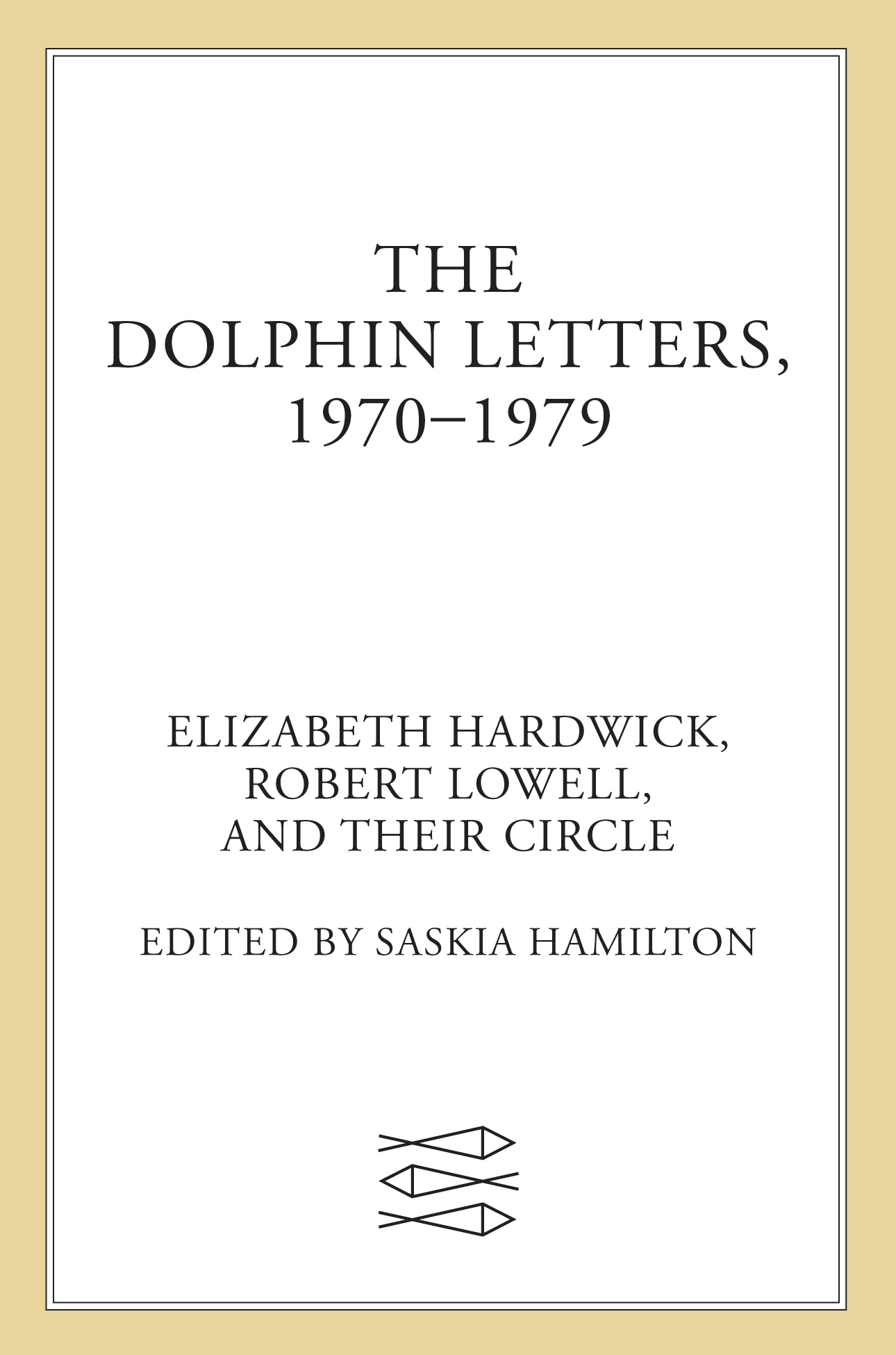The author and publisher have provided this e-book to you for your personal use only. You may not make this e-book publicly available in any way. Copyright infringement is against the law. If you believe the copy of this e-book you are reading infringes on the authors copyright, please notify the publisher at: us.macmillanusa.com/piracy.
Should revelation be sealed like private letters,
till all the beneficiaries are dead,
and our proper names become improper Lives?
Robert Lowell, Draw [Doubt 1], The Dolphin
Was that written for the archives? Who is speaking?
Elizabeth Hardwick, Sleepless Nights
Until the end of her life, Elizabeth Hardwick wondered what had happened to the letters she wrote to Robert Lowell during the 1970s. They are lost or gone, she said to Lowells biographer and, referring to the use Lowell had made of her letters in his book The Dolphin, she added, I suppose he was so busy cutting them up! (laughter).
The Dolphin Letters collects the correspondence between Hardwick and Lowell during the last seven years of Lowells lifeHardwicks side of which surfaced only after her death more than thirty years laterand offers a portrait of two writers at a time of intense personal crisis and creative innovation. Both relied on intelligent and telegraphic communications with each other while going through their separation and divorce; and afterward, through the years during which Lowell published four books of poetry, including The Dolphin, Hardwick wrote Seduction and Betrayal: Women and Literature and Sleepless Nights, and their daughter, Harriet, grew from thirteen to twenty years old. A written record cannot but be incomplete your whole self and your writing self are different, as Hardwick once remarkedand this portrait is necessarily partial, framed as it is by a period of distress that alters the proportions of the lives represented. Lowells romance with and marriage to Caroline Blackwood happen offstage, as does the family life they made with their son, Sheridan, Blackwoods three daughters, and Harriet. Hardwicks romantic involvements during this period are not mentioned. Nevertheless, the correspondence gives us their written character and temperament both within and outside of the marriage during this period (included in the book are significant exchanges with friends in their circle), in their distinct qualities of mind and sentence.
The book opens with Hardwicks return to New York with Harriet after a family trip to Italy in the spring of 1970. Lowell and Hardwick were both fifty-three years old and had been married since 1949. Harriet was due back at school to finish the seventh grade, and Hardwick to finish the semesters teaching at Barnard College. Lowell, who was on his way to take up an eight-week fellowship at All Souls College, Oxford, extended his travels from Rome to Amsterdam to visit old friends, and then on to England. He was at the time considering a separate teaching offer from the University of Essex, which would have involved moving the family to England for two years, not least to seek respite from the stresses of his recent American life. These included his commitments to teaching (he commuted every week from New York to Harvard) and to activisma dedication, as Hardwick called it,
Lowell arrived at All Souls on April 24. Six days later, he attended a party in his honor given by his British publisher, Faber & Faber. Caroline Blackwood, whom he had met some years previously, was there, and they were reintroduced.
During Lowell and Hardwicks previous twenty-one years together, Lowell had suffered at least ten major manic episodes and at least fifteen hospitalizations, and was administered the therapies available at the time (seclusion and shock treatment in 1949; chlorpromazine, hydrotherapy, and psychoanalysis from the 1950s until the mid-1960s; lithium, newly available in the United States, in his fiftieth year). Manic-depressive illness is an episodic but also a progressive disease; and by 1961 Lowells cycle of acute mania, hospitalization, and depression began to recur yearly.
Fortunately, Cal
When Lowell was first prescribed lithium, it granted him release from both the yearly attacks and his anxiety about when the next would strike. One should not understate how powerful it might have been for him to be freed of such a severe and painful illness, Harriet Lowell writes. If a salt could stop the attacks, that meant the illness was not caused by some terrible character flaw.
But to some old friends there seemed another, subtle change, as if the difference in his character and temperament when well and when sick was a little less distinct, even if his gentleness and intelligence were undiminished. From 1967 to 1970 Lowell worked on the unstopping composition of the Notebook poems (numbering 377 by the publication of the third edition), which was connected, Lowell wrote to Hardwick in apology, to the stirring and blurring of drinking. Ive been hard going the last couple of years, though when havent I been?
In May 1970, Hardwick sensed very quickly from Lowells silences and evasions that he was again in love, and that he was not at all well. By mid-May, her letters appear to be keeping up a pretense of daily conversationabout Harriet and the household, plans for moving to England, the social scene, the extraordinary political events unfolding, the U.S. bombing of Cambodia, the New Haven Black Panther trials, the killings of students at Kent State and Jackson Statebecause she knew something was wrong but couldnt ask. PERSONAL DIFFICULTIES: as she feared, his affair (with whom, she had yet to learn) and his weeks at All Souls were prelude to a severe manic episodehis first since his lithium treatment had begun three years earlier. During the summer of 1970, it was not clear to anyone, Lowell included, whether his feelings for Blackwood were symptomatic of his illness. After nearly two months, when Hardwick finally learned with whom Lowell had taken up, she was doubtful about Blackwood as a partner for him. Part of her distress was not knowing whether Blackwood could cope with his mental illness if it returned full force, Harriet Lowell writes.
Though none of Lowells previous affairs had lasted, this alliance proved different. I am not mad and hold to you with reason, he later wrote in a poem to Blackwood.
Lowell and Hardwicks separation was conducted mostly through letters in the summer and fall of 1970. A practical reason for writing instead of telephoning was the expense of transatlantic calls and the uneven quality of reception (crossed lines, echoes) impeding the flow of conversation. I am sorry I was so mute on the phone. At the start two others seemed competing with you, Lowell writes after one such call. A letter is also of the moment, and quickly posted. Harder to control in a genuine correspondence (not one written for the art of fiction) is the vacillation of feeling from one letter to the next.
Letters both real and fictional are a formal device in Lowells poetry of the late 1960s and early 1970s, and in Hardwicks prose. Experimenting with autobiography and immediacy in the Notebook poems, Lowell had versed a letter from Allen Tate into a poem for the 1969 first edition. In the spring of 1970, he did the same with a letter from Elizabeth Bishop for the third edition. That autumn, as he began to write in his adapted sonnet form about a suffering hero?


